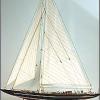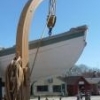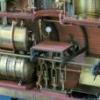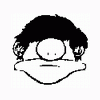MORE HANDBOOKS ARE ON THEIR WAY! We will let you know when they get here.
×
-
Posts
818 -
Joined
-
Last visited
Reputation Activity
-
 _SalD_ got a reaction from canoe21 in US Brig Syren by _SalD_ – FINISHED - 3/16" scale
_SalD_ got a reaction from canoe21 in US Brig Syren by _SalD_ – FINISHED - 3/16" scale
Almost finished with chapter five!!
The hull is sanded down and stained. Reading through a number of Syren build logs here on MSW regarding staining the hull I decided to go with a 40-60 mixture of golden oak and natural stain. I tried this mixture on some test strips and liked the shade however when I used it on the hull itself the color came out a little darker than what I was looking for. It’s not bad in fact the admiral really likes it so I guess it’s a done deal.
For the treenail layout instead of drawing lines on the hull I used something similar to what Dirk did in his build. I used a transparent sheet to print out the reference lines denoting the location of the bulwark’s. Holding this sheet on the side of the hull with clothes pins I was able to make small indentations into the planking by poking holes through the plastic sheet with a compass point held in a mechanical pencil. To make the holes I used a pin vise with a 0.02 inch (0.5mm) drill bit and then rounded them out by inserting the tip of the compass point. To fill the holes I first tried a dark shade (#8 minwax) blend stick but thought the holes stood out too much. I wanted a more subtle look so I went with a lighter shade (#3) blend stick. The holes can be seen when you look at the hull at different angles so you can tell they are there, but they don’t over power the ship.
Treenails on left of the gun port are the lighter shade,darker to the right.
After marking the waterline (not one of my favorite tasks) I taped the hull ready for painting.
Almost forgetting, I finally glued the lower deck in place.
-
 _SalD_ got a reaction from PaddyO in US Brig Syren by _SalD_ – FINISHED - 3/16" scale
_SalD_ got a reaction from PaddyO in US Brig Syren by _SalD_ – FINISHED - 3/16" scale
I thought I would update my log while waiting for the blizzard to hit southern New England. They are predicting 20 to 30 inches by tomorrow night.
Well I finally found the piece of planking I was looking for the past several weeks (the last piece). With the hull finished I moved onto the stern and completed the counter and transom.
Next I added the second layer of planking to the wales. In hind sight I should have formed these planks at the same time I was doing the first set of wales and kept them for later so I could have glued them right in place. Since I didn't do that I used a set of pins that I modified to hold the plank in place after soaking. I inserted the pins along the seam between the second and third wale to give me a support for the new wale and to hold it in place while it dried. I have to apologize to the person who's log here on MSW I learned how to make the pins but I just can't find it now.
Once this wale was dry and glued into place I used it to form against for the upper and lower wale. When dried they were glued in place.
The sheer strake was then soaked and clamped in position until dry and then glued in place. Prior to gluing the sheer strake on I cutout the four opening for the sheaves directly below it. The sheaves were made from pear wood with a small piece of 1/8” diameter brass tube for the pulley held in place with a toothpick for the axle. They are not glued in yet, I will do that after all the sanding and finishing is done.
All in all I am pleased how the hull came out for my first attempt at a POB ship. I still need to sand the hull down and do some treenailing. Something to do while waiting to get plowed out from the blizzard.
-
 _SalD_ got a reaction from canoe21 in US Brig Syren by _SalD_ – FINISHED - 3/16" scale
_SalD_ got a reaction from canoe21 in US Brig Syren by _SalD_ – FINISHED - 3/16" scale
Update on the planking. Starboard side is complete and only a few more planks to go on the port side. (Phew!! ) One thing I’ve discovered is that even the best laid plans can go awry. After carefully laying out the planking profile for the hull I’ve ended up using a few partial planks at the center of the hull. I didn’t bother shading the edges of the planks to simulate the caulking since the hull is going to be plated.
Starboard side, not sanded yet. Port side with a few planks left to go.
Bow
I’ve also started planking the counter. Planks around the tuck look a little ragged but they should clean up okay with the final sanding.
On a separate note, I’ve always had a hard time keeping a square edge on the little pieces of wood that I sand. To help me do a better job I made a little disc sander for my dremel flex-extension with some scrap pieces of wood. I made a holder that the end of the extension sits in and is clamped in place. For the disc I used a cap from a vitamin bottle and cut out round pieces of sandpaper, of different grit, held in place with double sided tape. Now I can sand the ends square or at an angle using different drafting triangles.
-
 _SalD_ got a reaction from PaddyO in US Brig Syren by _SalD_ – FINISHED - 3/16" scale
_SalD_ got a reaction from PaddyO in US Brig Syren by _SalD_ – FINISHED - 3/16" scale
I finished placing the two 5/32” wales below the top most wale and the first 1/8” plank below them. I also completed placing the garboard plank and the two 1/8” planks above it. To shape each plank to conform to the shape of the hull I soaked and steamed each plank and then temporarily pinned them to the hull. After letting them dry in place I removed them and glued them back into position.
The one deviation I made from the instructions was that I decided to skip Step 2 and not install the counter planking or the transom at the stern until I finished planking the hull. I decided to do this for two reasons. 1) Because of the way the counter planking and transom fit over the ends of the hull planking, I thought it would be easier to shape the counter planking if the hull planking was already in place. And 2) I thought it would be easier to ‘tuck’ the hull planks around the counter if the planking was not on the counter yet. I guess I’ll find out if it was a good or bad decision.
Forming the second wale in place
Wales glued in place and forming the first 1/8" plank
Bending the plank around the 'tuck' of the counter
Garboard glued in place
Forming the first 1/8" planks above the garboard. Did both port and starboard sides at the same time. Push pins seemed to work very well at holding the planks in position.
Planking at the counter
Garboard and first two planks in place
Port side with simulated butt ends of planking on wales to get an idea of how the second layer of wales should look.
Stern. Pencil line on the counter denotes, what should be, the location of the bottom edge of the last plank of the counter.
Sorry for all the photo's, just a few more
-
 _SalD_ got a reaction from PaddyO in US Brig Syren by _SalD_ – FINISHED - 3/16" scale
_SalD_ got a reaction from PaddyO in US Brig Syren by _SalD_ – FINISHED - 3/16" scale
I tried a little different approach for placing the planking above the wales than what is described in the instructions. After pondering the pros and cons of placing these planks in a number of pieces as per the instructions or in one continuous piece I went with the one piece. I know it’s not the way it was done way back when but the practical side of me took control and decided to deviate a bit from the norm. Before setting the planks I use my jig to pre-bend the bow end of the planks.
Prior to setting the first plank I cut in four grooves across the plank to denote the faux ends that would have been made by the individual pieces. For the second plank I notch out for the gun ports and sweeps but kept it as one long plank.
Clamping the first plank in position
First and second plank above the wale
The remaining five planks were all set as continuous pieces from stem to stern.
Then using the notches in the second planks as guides I cut out the gun ports. I still need to do the sweeps.
I took care not to get glue on the exposed portion of the gun port frames so the planking would not stick there.
-
 _SalD_ got a reaction from canoe21 in US Brig Syren by _SalD_ – FINISHED - 3/16" scale
_SalD_ got a reaction from canoe21 in US Brig Syren by _SalD_ – FINISHED - 3/16" scale
Stern framing
I pretty much followed the instructions for assembling the stern framing. Inserted the spacers along bulkhead #26 and glued the frames in between. One thing I did different was to add a temporary support below the counter to give the spacers and frames something to sit on to help support them.
After all the frames were set and the glue dried I cut and inserted the gun port sills. For this I used a temporary batten to establish the top of the sill. I also checked their position with the cannon template to make sure the sills were not too high.
After the sills were set and dried I did the gun port lintels and added the rest of the filler material. I still need to mark the outside frames to get the proper shape of the stern so I painted the frames white so I'll be able to see the pencil marks to trim along a little better. Old eyes ain't what they use to be.
Before I start sanding all this framing down I have a question as to what the final profile should look like. I’ve looked at a few of the current logs here but I’m still unsure. I guess what I’m not sure about is how does the stern planking match up to the hull planking? The filler pieces added below the counter in the directions shows a smooth transition from the filler to the stern framing. If I add the filler called for in the manual I have a little lip between the filler and the framing. Do I use a wider filler or do I sand the stern frames down to eliminate the lip? I think I should use a wider filler. I hope this makes sense.
Duh.....Well after rereading the instructions again I think I found my answer. and I quote..."The strip under the counter should be set flush to the edge of the counter". Unless I am misinterpreting this I need to use a wider strip.
-
 _SalD_ got a reaction from EricWilliamMarshall in US Brig Syren by _SalD_ – FINISHED - 3/16" scale
_SalD_ got a reaction from EricWilliamMarshall in US Brig Syren by _SalD_ – FINISHED - 3/16" scale
After a little procrastination I started plating the hull. For me, plating is a little like taking a bath when you’re a kid, you hate to get in but once you are you hate to get out. To start I cut 30” long strips of copper tape to put through the jig. I then cut that strip into smaller more manageable segments. I have to say that the chisel blade on the stamp worked out very well. Before I started the coppering I attached a temporary piece of wood to the deck so I could hold the ship in my keel vise. This made it much easier to work on the inverted hull. The screws holding the wood are positioned where the hatches will go and the deck will be repaired after the wood piece is removed.
The actual plating went well with no major boo boos. In fact I found this ship to be easier than when I did the Phantom’s plates. Not as much cutting of the plates and the larger size plates are easier to handle. To keep finger prints off the copper I wore latex gloves and to fix the plates in place I went over them with a wallpaper seam roller. Please excuse the photos, it's hard taking good pictures of the plates
Started with the keel
Continuing on
Finished the port side
No dressing belt yet
When I got to the dressing belts I thought to myself, self, the only real difference between the hull plates and the dressing belt are four additional holes along the top of the plate. So instead of making two new stamps for the dressing belt plates, even though I had all the material ready to make them, I just used a burnishing tool to place the four additional holes in the plates I already had. One thing I found that helped a lot with placing the dressing belt that I really didn't plan but worked out well was that when I painted the waterline I had taped off it's exact location. Afterwards I thought it would be a good idea if I painted a little below the waterline to give me some room for errors. What happened was I got a nice tape line marking the position of the waterline between the two applications of the black paint.
Dressing belt
Started the starboard side Finished the starboard
Done, time to get out of the tub , on to the rudder
-
 _SalD_ got a reaction from canoe21 in US Brig Syren by _SalD_ – FINISHED - 3/16" scale
_SalD_ got a reaction from canoe21 in US Brig Syren by _SalD_ – FINISHED - 3/16" scale
After a little procrastination I started plating the hull. For me, plating is a little like taking a bath when you’re a kid, you hate to get in but once you are you hate to get out. To start I cut 30” long strips of copper tape to put through the jig. I then cut that strip into smaller more manageable segments. I have to say that the chisel blade on the stamp worked out very well. Before I started the coppering I attached a temporary piece of wood to the deck so I could hold the ship in my keel vise. This made it much easier to work on the inverted hull. The screws holding the wood are positioned where the hatches will go and the deck will be repaired after the wood piece is removed.
The actual plating went well with no major boo boos. In fact I found this ship to be easier than when I did the Phantom’s plates. Not as much cutting of the plates and the larger size plates are easier to handle. To keep finger prints off the copper I wore latex gloves and to fix the plates in place I went over them with a wallpaper seam roller. Please excuse the photos, it's hard taking good pictures of the plates
Started with the keel
Continuing on
Finished the port side
No dressing belt yet
When I got to the dressing belts I thought to myself, self, the only real difference between the hull plates and the dressing belt are four additional holes along the top of the plate. So instead of making two new stamps for the dressing belt plates, even though I had all the material ready to make them, I just used a burnishing tool to place the four additional holes in the plates I already had. One thing I found that helped a lot with placing the dressing belt that I really didn't plan but worked out well was that when I painted the waterline I had taped off it's exact location. Afterwards I thought it would be a good idea if I painted a little below the waterline to give me some room for errors. What happened was I got a nice tape line marking the position of the waterline between the two applications of the black paint.
Dressing belt
Started the starboard side Finished the starboard
Done, time to get out of the tub , on to the rudder
-
 _SalD_ got a reaction from jdbradford in US Brig Syren by _SalD_ – FINISHED - 3/16" scale
_SalD_ got a reaction from jdbradford in US Brig Syren by _SalD_ – FINISHED - 3/16" scale
After a little procrastination I started plating the hull. For me, plating is a little like taking a bath when you’re a kid, you hate to get in but once you are you hate to get out. To start I cut 30” long strips of copper tape to put through the jig. I then cut that strip into smaller more manageable segments. I have to say that the chisel blade on the stamp worked out very well. Before I started the coppering I attached a temporary piece of wood to the deck so I could hold the ship in my keel vise. This made it much easier to work on the inverted hull. The screws holding the wood are positioned where the hatches will go and the deck will be repaired after the wood piece is removed.
The actual plating went well with no major boo boos. In fact I found this ship to be easier than when I did the Phantom’s plates. Not as much cutting of the plates and the larger size plates are easier to handle. To keep finger prints off the copper I wore latex gloves and to fix the plates in place I went over them with a wallpaper seam roller. Please excuse the photos, it's hard taking good pictures of the plates
Started with the keel
Continuing on
Finished the port side
No dressing belt yet
When I got to the dressing belts I thought to myself, self, the only real difference between the hull plates and the dressing belt are four additional holes along the top of the plate. So instead of making two new stamps for the dressing belt plates, even though I had all the material ready to make them, I just used a burnishing tool to place the four additional holes in the plates I already had. One thing I found that helped a lot with placing the dressing belt that I really didn't plan but worked out well was that when I painted the waterline I had taped off it's exact location. Afterwards I thought it would be a good idea if I painted a little below the waterline to give me some room for errors. What happened was I got a nice tape line marking the position of the waterline between the two applications of the black paint.
Dressing belt
Started the starboard side Finished the starboard
Done, time to get out of the tub , on to the rudder
-
 _SalD_ got a reaction from Landlocked123 in US Brig Syren by _SalD_ – FINISHED - 3/16" scale
_SalD_ got a reaction from Landlocked123 in US Brig Syren by _SalD_ – FINISHED - 3/16" scale
After a little procrastination I started plating the hull. For me, plating is a little like taking a bath when you’re a kid, you hate to get in but once you are you hate to get out. To start I cut 30” long strips of copper tape to put through the jig. I then cut that strip into smaller more manageable segments. I have to say that the chisel blade on the stamp worked out very well. Before I started the coppering I attached a temporary piece of wood to the deck so I could hold the ship in my keel vise. This made it much easier to work on the inverted hull. The screws holding the wood are positioned where the hatches will go and the deck will be repaired after the wood piece is removed.
The actual plating went well with no major boo boos. In fact I found this ship to be easier than when I did the Phantom’s plates. Not as much cutting of the plates and the larger size plates are easier to handle. To keep finger prints off the copper I wore latex gloves and to fix the plates in place I went over them with a wallpaper seam roller. Please excuse the photos, it's hard taking good pictures of the plates
Started with the keel
Continuing on
Finished the port side
No dressing belt yet
When I got to the dressing belts I thought to myself, self, the only real difference between the hull plates and the dressing belt are four additional holes along the top of the plate. So instead of making two new stamps for the dressing belt plates, even though I had all the material ready to make them, I just used a burnishing tool to place the four additional holes in the plates I already had. One thing I found that helped a lot with placing the dressing belt that I really didn't plan but worked out well was that when I painted the waterline I had taped off it's exact location. Afterwards I thought it would be a good idea if I painted a little below the waterline to give me some room for errors. What happened was I got a nice tape line marking the position of the waterline between the two applications of the black paint.
Dressing belt
Started the starboard side Finished the starboard
Done, time to get out of the tub , on to the rudder
-
 _SalD_ got a reaction from EricWilliamMarshall in US Brig Syren by _SalD_ – FINISHED - 3/16" scale
_SalD_ got a reaction from EricWilliamMarshall in US Brig Syren by _SalD_ – FINISHED - 3/16" scale
Thanks Augie, funny you should ask about the finish. Reading through Chuck's old build log he had mentioned that he discovered (by accident) that using spf 50 sun tan lotion on the plates gave them a nice finish and did not show fingerprints. Well I PM him to make sure he would still recommend doing that and he replied that he would. I am going to make up some test strips to see how the lotion works and if I like it that's what I'll be doing.
-
 _SalD_ reacted to GLakie in US Brig Syren by _SalD_ – FINISHED - 3/16" scale
_SalD_ reacted to GLakie in US Brig Syren by _SalD_ – FINISHED - 3/16" scale
Nice job Sal! Great ideas with the wood for the clamp and the gloves.
-
 _SalD_ got a reaction from mspringer in US Brig Syren by _SalD_ – FINISHED - 3/16" scale
_SalD_ got a reaction from mspringer in US Brig Syren by _SalD_ – FINISHED - 3/16" scale
After a little procrastination I started plating the hull. For me, plating is a little like taking a bath when you’re a kid, you hate to get in but once you are you hate to get out. To start I cut 30” long strips of copper tape to put through the jig. I then cut that strip into smaller more manageable segments. I have to say that the chisel blade on the stamp worked out very well. Before I started the coppering I attached a temporary piece of wood to the deck so I could hold the ship in my keel vise. This made it much easier to work on the inverted hull. The screws holding the wood are positioned where the hatches will go and the deck will be repaired after the wood piece is removed.
The actual plating went well with no major boo boos. In fact I found this ship to be easier than when I did the Phantom’s plates. Not as much cutting of the plates and the larger size plates are easier to handle. To keep finger prints off the copper I wore latex gloves and to fix the plates in place I went over them with a wallpaper seam roller. Please excuse the photos, it's hard taking good pictures of the plates
Started with the keel
Continuing on
Finished the port side
No dressing belt yet
When I got to the dressing belts I thought to myself, self, the only real difference between the hull plates and the dressing belt are four additional holes along the top of the plate. So instead of making two new stamps for the dressing belt plates, even though I had all the material ready to make them, I just used a burnishing tool to place the four additional holes in the plates I already had. One thing I found that helped a lot with placing the dressing belt that I really didn't plan but worked out well was that when I painted the waterline I had taped off it's exact location. Afterwards I thought it would be a good idea if I painted a little below the waterline to give me some room for errors. What happened was I got a nice tape line marking the position of the waterline between the two applications of the black paint.
Dressing belt
Started the starboard side Finished the starboard
Done, time to get out of the tub , on to the rudder
-
 _SalD_ got a reaction from Foultide in US Brig Syren by _SalD_ – FINISHED - 3/16" scale
_SalD_ got a reaction from Foultide in US Brig Syren by _SalD_ – FINISHED - 3/16" scale
After a little procrastination I started plating the hull. For me, plating is a little like taking a bath when you’re a kid, you hate to get in but once you are you hate to get out. To start I cut 30” long strips of copper tape to put through the jig. I then cut that strip into smaller more manageable segments. I have to say that the chisel blade on the stamp worked out very well. Before I started the coppering I attached a temporary piece of wood to the deck so I could hold the ship in my keel vise. This made it much easier to work on the inverted hull. The screws holding the wood are positioned where the hatches will go and the deck will be repaired after the wood piece is removed.
The actual plating went well with no major boo boos. In fact I found this ship to be easier than when I did the Phantom’s plates. Not as much cutting of the plates and the larger size plates are easier to handle. To keep finger prints off the copper I wore latex gloves and to fix the plates in place I went over them with a wallpaper seam roller. Please excuse the photos, it's hard taking good pictures of the plates
Started with the keel
Continuing on
Finished the port side
No dressing belt yet
When I got to the dressing belts I thought to myself, self, the only real difference between the hull plates and the dressing belt are four additional holes along the top of the plate. So instead of making two new stamps for the dressing belt plates, even though I had all the material ready to make them, I just used a burnishing tool to place the four additional holes in the plates I already had. One thing I found that helped a lot with placing the dressing belt that I really didn't plan but worked out well was that when I painted the waterline I had taped off it's exact location. Afterwards I thought it would be a good idea if I painted a little below the waterline to give me some room for errors. What happened was I got a nice tape line marking the position of the waterline between the two applications of the black paint.
Dressing belt
Started the starboard side Finished the starboard
Done, time to get out of the tub , on to the rudder
-
 _SalD_ got a reaction from Gahm in US Brig Syren by _SalD_ – FINISHED - 3/16" scale
_SalD_ got a reaction from Gahm in US Brig Syren by _SalD_ – FINISHED - 3/16" scale
After a little procrastination I started plating the hull. For me, plating is a little like taking a bath when you’re a kid, you hate to get in but once you are you hate to get out. To start I cut 30” long strips of copper tape to put through the jig. I then cut that strip into smaller more manageable segments. I have to say that the chisel blade on the stamp worked out very well. Before I started the coppering I attached a temporary piece of wood to the deck so I could hold the ship in my keel vise. This made it much easier to work on the inverted hull. The screws holding the wood are positioned where the hatches will go and the deck will be repaired after the wood piece is removed.
The actual plating went well with no major boo boos. In fact I found this ship to be easier than when I did the Phantom’s plates. Not as much cutting of the plates and the larger size plates are easier to handle. To keep finger prints off the copper I wore latex gloves and to fix the plates in place I went over them with a wallpaper seam roller. Please excuse the photos, it's hard taking good pictures of the plates
Started with the keel
Continuing on
Finished the port side
No dressing belt yet
When I got to the dressing belts I thought to myself, self, the only real difference between the hull plates and the dressing belt are four additional holes along the top of the plate. So instead of making two new stamps for the dressing belt plates, even though I had all the material ready to make them, I just used a burnishing tool to place the four additional holes in the plates I already had. One thing I found that helped a lot with placing the dressing belt that I really didn't plan but worked out well was that when I painted the waterline I had taped off it's exact location. Afterwards I thought it would be a good idea if I painted a little below the waterline to give me some room for errors. What happened was I got a nice tape line marking the position of the waterline between the two applications of the black paint.
Dressing belt
Started the starboard side Finished the starboard
Done, time to get out of the tub , on to the rudder
-
 _SalD_ reacted to Gahm in US Brig Syren by Gahm - Model Shipways
_SalD_ reacted to Gahm in US Brig Syren by Gahm - Model Shipways
A little update. Things as usual are moving very slowly due to lack of modeling time (what’s new ? ). I finished the first 4 carronade carriages and the first “production” carronade (image 1).
Images 2 a-d show the fabrication of the hinges for the gun barrels. For this I milled a grove into a brass strip and silver soldered a brass tube into the grove. The result is shown in image 2a. To cut hinges from this piece with always the same width I combined my Taig lathe and my rotary tool with flex shaft (in lack of a suitable table saw) to a metal cutting device (see images 2b and c). The resulting hinges are shown in image 2d.
Image 3a and b present the method I used to determine the correct location of the hinges on the carronade carriage. I placed the gun barrel-hinge assembly on the carriage in such a way that the elevation screw was located correctly on the metal fitting and marked the front end of the hinges with masking tape. As a next step I placed the hinges alone nicely centered on the carriage, with the right distance between them and the front end aligned with the masking tape (image 3a). To help with this process I covered the carriage first with further masking tape and a double-sided sticky tape on top of the masking tape. Once aligned satisfactorily I marked the 2 front ends of the hinges on the masking tape, removed every tape with the exception of the tape with the alignment marks and mounted the hinges permanently using these marks (image 3b). Finally the gun barrel was mounted, the elevation adjusted with the elevation screw, and barrel and screw glued in place. The final result is displayed in images 4 and 5. Images 6 and 7 show the first carronade in its final place on my Syren model.
Thomas
Image 1
Image 2
Image 3
Image 4
Image 5
Image 6
Image 7
-
 _SalD_ got a reaction from cg451 in US Brig Syren by rameyke - Model Shipways
_SalD_ got a reaction from cg451 in US Brig Syren by rameyke - Model Shipways
Ken,
1. did you use the temporary batten to mark the position of the first wale before gluing it to the hull? It will show you if you need to make any adjustments from the prescribed marks on the bulkheads.
2. for the bow end of the plank I chamfered the back edge a little to make it fit better into the rabbet. see sketch below.
Also, maybe it's just my old eyes but, it appears from the pictures that the plank above the first wale is the same width, it should be smaller (1/8" wide).
-
 _SalD_ reacted to dafi in HMS Victory by dafi - Heller - PLASTIC - To Victory and beyond ...
_SalD_ reacted to dafi in HMS Victory by dafi - Heller - PLASTIC - To Victory and beyond ...
... Pandora´s box is slowly opening ...
...
XXXDan -
 _SalD_ reacted to popeye the sailor in Andrea Gail by popeye the Sailor - FINISHED - 1:20 scale
_SalD_ reacted to popeye the sailor in Andrea Gail by popeye the Sailor - FINISHED - 1:20 scale
that was a lot quicker than with Vista........down and back up in no time! I also need to make vents for around the fore deck.......three of them. these are unlike the normal vents seen on larger ships......they look like nothing more than curved pipe. I had bought some hollow round styrene, but it's too large.....so, I'm going to do it from smaller size dowel. I cut a bunch of angled pieces......I put the puzzles together later
during all this, I had filled the openings of the spot lights with window maker. enough time had passed......lets take a look..
.......
Oh........say it isn't so! the bubble broke in the middle! the other one?.......
I'd say it gone from bad to worse...this is not good I guess the opening is too large a span for the maker to work! it's a good thing I have a backup plan........we'll get back to it later meanwhile.......back at the vents.
I began to piece together the bit to form the curve.......I think I need to make them with just a little more length.
I'll need to make some more.......I'm on the right track though, so that's a good thing. since the lights were a bust, I might as well get the window maker out of them, before it totally dries......at least I can salvage them.
out of all this.....there was at least one small ray of light.......the orbcom GPS module
-
 _SalD_ got a reaction from canoe21 in US Brig Syren by _SalD_ – FINISHED - 3/16" scale
_SalD_ got a reaction from canoe21 in US Brig Syren by _SalD_ – FINISHED - 3/16" scale
Chapter 8 – coppering the hull
Prior to coppering the hull I need to make the stamps for the simulated nail heads in the copper plates. I will be using the nail pattern that Chuck shows in the instructions for the port and starboard plates and after studying Dirk’s (Dubz) build I will be making two additional stamps for the port and starboard dressing belts. The patterns were drawn to 3/16” scale using AutoCAD.
For the pins I used 26 gauge Lancets, bought at Wal-Mart, as mentioned in Richard’s (rtropp) and Thomas’s (Gahm) builds. I went with the thicker 26 gauge lancets and not the 30 gauge as Thomas used because I wasn’t showing as many nails he did. Extracting the needle from the plastic holder proved to be a challenge and what I finally did was; using my propane torch I heated the metal tip thus softening the plastic around the needle so it could be pulled out easier. Disclaimer: If you use this technique please be aware that the plastic does burn so use caution and have a cup of water on hand to place the plastic holder in.
I used some scrap poplar to make the stamp and cut it to the dimensions shown in the instructions. I glued the nail pattern on it as a guide and then I got to use the Christmas present from the Admiral (Proxxon drill press with compound table).
After drilling all the holes I inserted the pins and glued them in. Prior to inserting them I did cut about a ¼” off the needles (sharp end) so they wouldn’t stick out so much. One modification I made to the stamp was to attach an X-Acto chisel blade to one end of the stamp at the same height as the pins. I believe it’s a #17 blade and it fit the ¼” wide stamp perfectly. I attached the blade to mark the copper where I would need to make the cut for the individual plates, I found however that by applying just the right amount of force the blade will cut the copper but not the paper backing. I also made the opening in the jig a 1/16” larger to account for the blade thickness.
-
 _SalD_ got a reaction from CharlieZardoz in US Brig Syren by _SalD_ – FINISHED - 3/16" scale
_SalD_ got a reaction from CharlieZardoz in US Brig Syren by _SalD_ – FINISHED - 3/16" scale
I was a little disappointed in the way I finished the deck and I learned what not to do next time. I drilled all the holes for the treenails prior to staining the deck which in hind sight I don’t think was a good idea. Prior to staining the deck I stained a test strip with holes in it similar to the deck and found that the stain was bleeding into the holes making a dark ring at each hole. To avoid this I filled all the holes with wood filler before staining. There was no bleeding into the holes but the stain was a little blotchy (yes Augie I tried pre-stain this time). I believe it was from not sanding the deck enough to remove all the wood filler that was on the surface. I was a little reluctant to sand too much in fear of sanding through the deck plank but again in hind sight there was plenty of material left to sand.
For the treenails I decided to show only the treenails located along the deck beams where I had a butt joint and not at every beam between the bulkheads. I thought it would be too much, not to mention I didn’t want to drill all those holes. The only problem was that after I filled them with wood filler and stained the deck the treenails didn’t show up too well. I may redo them.
For the waterway I tried a few different procedures to make the triangular chamfer strip from the 1/16” square stock. There is probably a real simple way of doing this but what I came up with was; first I cut a V-groove in a piece of scrap pine using a V gouge, making the depth of the groove slightly less than the finished shape of the waterway. Next I taped two erasing shields on either side of the groove to avoid sanding into the pine. The shields are 0.1 mm thick. Then I laid the wood strip in the groove and removed the top half using my dremel’s drum sanding attachment. What was left was a nice 1/16” X 1/16” chamfer strip.
-
 _SalD_ got a reaction from canoe21 in US Brig Syren by _SalD_ – FINISHED - 3/16" scale
_SalD_ got a reaction from canoe21 in US Brig Syren by _SalD_ – FINISHED - 3/16" scale
The deck planking went surprisingly well. I’m glad I used the tick strips along the bulkheads because they were a big help in keeping the stern planking in line. I’m also glad I the used balsa wood infill between the bulkheads because it gave me something to set the push pins in to hold the planking in place.
Nibbing the planks at the bow wasn’t as hard as I thought it was going to be either. The only problem I discovered after I had installed most of the nibbed plank was that I didn’t pay close enough attention the diagonal length of each nib on corresponding planks, either side of the centerline. This resulted in the flat portion of the nib, on corresponding planks, not starting in the exact location along the margin plank. Lesson learned for next time.
Planking in progress Push pins used to hold planking in place
Planking complete, not sanded Planking sanded, no finish
Aft companion way opening cut out Marking hatch and mast locations
This is a little off topic but whenever I do any major home improvement projects, e.g. finishing off the basement, which involves framing walls and installing drywall I have a little habit of hiding a little something in the wall just in case someone in the distance future knocks the wall down. So prior to putting up the last piece of drywall I will put an empty (clean) beer bottle, with a dollar bill and note inside of it, in the wall. To that effect I decided to place a little something in the hull of the ship before finishing the planking. The beer bottle I couldn’t fit but the dollar and note went in okay. Who knows maybe a hundred years from now a budding model ship builder will buy the ship at a thrift shop and find the treasure and note while restoring it to its former glory.
-
 _SalD_ got a reaction from canoe21 in US Brig Syren by _SalD_ – FINISHED - 3/16" scale
_SalD_ got a reaction from canoe21 in US Brig Syren by _SalD_ – FINISHED - 3/16" scale
I decided not to use the laser cut margin plank that was provided with the kit because it would have required quite a bit of sanding to make it fit. I used the remaining 1/16” thick sheet of basswood I use for the cap rail to make the margin plank in one piece. I used a paper template to get the shape of the bulwarks and then traced it onto the wood sheet. It was then cut out, sanded to fit and glued in place.
We had one minor glitch with the margin plank when the apprentice carpenter, who was responsible for measuring it's length, appears to have used a tape measure with the first few inches broken off. Subsequently, the margin plank was a little short. Now this shipyard’s owner is very frugal and not wanting to spend the money for new planks decided to install a deck plank at the stern, athwart of the main deck planking to fill the gap. Similar to an edging plank in your hardwood floor.
Moving on.... After reviewing some of the build logs here on MSW I decided to place the deck planking similar to what Thomas (Gahm) did on his Syren, that is to follow the bulwarks with the planking toward the stern of the ship. I like how this looks so I thought I would give it a try. I would also like to thank Thomas for giving me a few pointers.
I don’t know if this is newbie over design but to help me keep the planks in alignment I pasted little tick strips along each bulkhead marking the location of each plank.
Since most of the first four planks on either side of the centerline will be covered by deck furnishings I decided to install each of them in two pieces. The ends of each plank meet at bulkhead ‘D’ where they will be covered by a grating hatch. The planks towards the stern were sanded down to fit the curve of the bulwarks with the aid of a template. All other planks will be installed cut to length per my layout drawing.
My planking ‘shop drawing’ to help me keep track of which plank I’m working on and where the butt ends are located.
-
 _SalD_ got a reaction from PaddyO in US Brig Syren by _SalD_ – FINISHED - 3/16" scale
_SalD_ got a reaction from PaddyO in US Brig Syren by _SalD_ – FINISHED - 3/16" scale
Ship is all repainted and ready for the deck.
-
 _SalD_ got a reaction from Jaggy in US Brig Syren by _SalD_ – FINISHED - 3/16" scale
_SalD_ got a reaction from Jaggy in US Brig Syren by _SalD_ – FINISHED - 3/16" scale
Finished the inboard planking and gave it a couple coats of paint.
I made the cap rail in one piece from a basswood sheet that was 3”x24”x1/16” thick. I used a heavy card stock to trace the top of the bulwarks instead of the wood sheet itself because it was a bit more flexible than the wood and less expensive if I messed it up. I cut the card stock pattern out, traced it on the wood sheet and then cut the rail out with an x-acto knife and sanded smooth.
While the cap rail glue was drying I made the 1/16” square molding strips that go along the outboard edge of the cap rail. I pretty much made these strips similar to the smaller molding strips at the stern by using my drafting triangles to hold the strip steady, then scoring the wood with an x-acto knife and then forming the groove with the compass point held in a mechanical pencil. The only difference was that for these strips I borrowed an idea from Richard’s (rtropp) build log and used a small piece of sandpaper folded in half to clean up the groove.
Before I start the decking I’m going to repaint everything (where's Earl Scheib when you need him) . The sheer plank, the stern cap rail and the upper wale got pretty beat up while installing the inboard planking and cap rail. Now I know why Dirk recommended not painting the black until everything was installed. Live and learn.


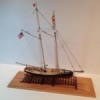
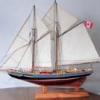
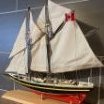
.thumb.jpeg.fc5d633a7b34428fcf19419a73d56d55.jpeg)
